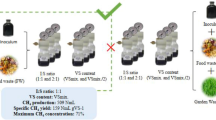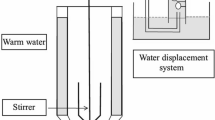Abstract
The unbalanced nutrients of municipal solid waste (MSW), particularly high carbon contents, were regarded as a major limiting factor to anaerobic digestion process. In this study, the addition of MSW in food waste (FW) feedstock to have a balanced C/N ratio was studied. Different co-substrate mixtures with C/N ratio of 20 to 40 were subjected to anaerobic batch experiment at lab scale, under mesophilic conditions. The biogas production decreased with the increase in C/N ratio due to insufficient availability of organic nitrogen for anaerobic microbial growth. Specific biogas and methane yields were observed to be 827 and 474.44 mL g−1VS, respectively, with volatile solids (VS) reduction rate of 88%, at C/N ratio of 20. Furthermore, the effect of the substrate to inoculum (S/I) ratio on digester performance was also studied. The biogas production decreased with the increase in S/I ratio due to the formation of more volatile fatty acids (VFAs) which led to decrease in pH and accumulated unionized ammonia-N. Specific biogas and methane yields were recorded to be 655 and 410.20 mL g−1VS, with 64% rate of biodegradability at S/I ratio of 0.5. Kinetics and statistics study showed that the higher S/I ratio could lead to VFA accumulation and result in low methane yield.




Similar content being viewed by others
References
Tanimu, M. I., Ghazi, T. I. M., Harun, R. M., & Idris, A. (2014). Effect of carbon to nitrogen ratio of food waste on biogas methane production in a batch mesophilic anaerobic digester. International Journal of Innovation, Management and Technology, 5, 116.
Lebiocka, M., & Piotrowicz, A. (2012). Co-digestion of sewage sludge and organic fraction of municipal solid waste. A comparison between laboratory and technical scales. Environment Protection Engineering, 38, 157–162.
Chufo, A., Yuan, H., Zou, D., Pang, Y., & Li, X. (2015). Biomethane production and physicochemical characterization of anaerobically digested teff (Eragrostis tef) straw pretreated by sodium hydroxide. Bioresource Technology, 181, 214–219.
Callaghan, F., Wase, D., Thayanithy, K., & Forster, C. (2002). Continuous co-digestion of cattle slurry with fruit and vegetable wastes and chicken manure. Biomass and Bioenergy, 22(1), 71–77.
Sreekrishnan, T., Kohli, S., & Rana, V. (2004). Enhancement of biogas production from solid substrates using different techniques - A Review. Bioresource Technology, 95, 1–10.
Parkin, G. F., & Owen, W. F. (1986). Fundamentals of anaerobic digestion of wastewater sludges. Journal of Environmental Engineering, 112(5), 867–920.
Chen, X., Pang, Y., Zou, D., Yuan, H., Liu, Y., Zhu, B., & Li, X. (2014). Optimizing acidogenic process for achieving high biomethane yield from anaerobic co-digestion of food waste and rice straw using response surface methodology. Journal of Biobased Materials and Bioenergy, 8(5), 512–518.
Sosnowski, P., Wieczorek, A., & Ledakowicz, S. (2003). Anaerobic co-digestion of sewage sludge and organic fraction of municipal solid wastes. Advances in Environmental Research, 7(3), 609–616.
Mshandete, A., Kivaisi, A., Rubindamayugi, M., & Mattiasson, B. (2004). Anaerobic batch co-digestion of sisal pulp and fish wastes. Bioresource Technology, 95(1), 19–24.
Elbeshbishy, E., Nakhla, G., & Hafez, H. (2012). Biochemical methane potential (BMP) of food waste and primary sludge: influence of inoculum pre-incubation and inoculum source. Bioresource Technology, 110, 18–25.
Fernández, J., Pérez, M., & Romero, L. I. (2008). Effect of substrate concentration on dry mesophilic anaerobic digestion of organic fraction of municipal solid waste (OFMSW). Bioresource Technology, 99(14), 6075–6080.
Chynoweth, D., Turick, C., Owens, J., Jerger, D., & Peck, M. (1993). Biochemical methane potential of biomass and waste feedstocks. Biomass and Bioenergy, 5(1), 95–111.
Haider, M. R., Yousaf, S., Malik, R. N., & Visvanathan, C. (2015). Effect of mixing ratio of food waste and rice husk co-digestion and substrate to inoculum ratio on biogas production. Bioresource Technology, 190, 451–457.
Martínez, M., Driller, L., Chamy, R., Schuch, W., Nogueira, M., & Fraser, P. (2016). In biogas potential of residues generated by the tomato processing industry under different substrate and inoculum conditions. XIV International Symposium on Processing Tomato, 1159, 151–158.
Satpathy, P., Steinigeweg, S., Cypionka, H., & Engelen, B. (2016). Different substrates and starter inocula govern microbial community structures in biogas reactors. Environmental Technology, 37(11), 1441–1450.
APHA, A. W., (1998). American Public Health Association/American Water Works Association/Water Environment Federation, Washington DC.
Van Soest, P. V., Robertson, J., & Lewis, B. (1991). Methods for dietary fiber, neutral detergent fiber, and nonstarch polysaccharides in relation to animal nutrition. Journal of Dairy Science, 74(10), 3583–3597.
Wang, X., Lu, X., Li, F., & Yang, G. (2014). Effects of temperature and carbon-nitrogen (C/N) ratio on the performance of anaerobic co-digestion of dairy manure, chicken manure and rice straw: focusing on ammonia inhibition. PLoS One, 9(5), e97265.
El-Mashad, H. M., & Zhang, R. (2010). Biogas production from co-digestion of dairy manure and food waste. Bioresource Technology, 101(11), 4021–4028.
De Mes, T., Stams, A., Reith, J., Zeeman, G., (2003). Methane production by anaerobic digestion of wastewater and solid wastes. Bio-Methane Bio-Hydrogen, 58–102.
Ahn, J. H., Shin, S. G., & Hwang, S. (2009). Effect of microwave irradiation on the disintegration and acidogenesis of municipal secondary sludge. Chemical Engineering Journal, 153(1-3), 145–150.
Wang, X., Yang, G., Feng, Y., Ren, G., & Han, X. (2012). Optimizing feeding composition and carbon–nitrogen ratios for improved methane yield during anaerobic co-digestion of dairy, chicken manure and wheat straw. Bioresource Technology, 120, 78–83.
Heo, N. H., Park, S. C., & Kang, H. (2004). Effects of mixture ratio and hydraulic retention time on singlestage anaerobic co-digestion of food waste and waste activated sludge. Journal of Environmental Science and Health, Part A Environmental Science, 39, 1739–1756.
Li, Y., Zhang, R., Liu, X., Chen, C., Xiao, X., Feng, L., He, Y., & Liu, G. (2013). Evaluating methane production from anaerobic mono- and co-digestion of kitchen waste, corn stover, and chicken manure. Energy & Fuels, 27(4), 2085–2091.
Nagao, N., Tajima, N., Kawai, M., Niwa, C., Kurosawa, N., Matsuyama, T., Yusoff, F. M., & Toda, T. (2012). Maximum organic loading rate for the single-stage wet anaerobic digestion of food waste. Bioresource Technology, 118, 210–218.
Brown, D., & Li, Y. (2013). Solid state anaerobic co-digestion of yard waste and food waste for biogas production. Bioresource Technology, 127, 275–280.
Murto, M., Björnsson, L., & Mattiasson, B. (2004). Impact of food industrial waste on anaerobic co-digestion of sewage sludge and pig manure. Journal of Environmental Management, 70(2), 101–107.
Kafle, G. K., & Kim, S. H. (2013). Anaerobic treatment of apple waste with swine manure for biogas production: batch and continuous operation. Applied Energy, 103, 61–72.
Gallert, C., Henning, A., & Winter, J. (2003). Scale-up of anaerobic digestion of the biowaste fraction from domestic wastes. Water Research, 37(6), 1433–1441.
Jaffar, M., Pang, Y., Yuan, H., Zou, D., Liu, Y., Zhu, B., Korai, R. M., & Li, X. (2016). Wheat straw pretreatment with KOH for enhancing biomethane production and fertilizer value in anaerobic digestion. Chinese Journal of Chemical Engineering, 24, 404–409.
Li, H., Guo, X., Cao, F., & Wang, Y. (2014). Process evolution of dry anaerobic co-digestion of cattle manure with kitchen waste. Chemical and Biochemical Engineering Quarterly, 28, 161–166.
Cui, Z., Shi, J., & Li, Y. (2011). Solid-state anaerobic digestion of spent wheat straw from horse stall. Bioresource Technology, 102(20), 9432–9437.
Yoon, Y. M., Kim, S. H., Shin, K. S., & Kim, C. H. (2014). Effects of substrate to inoculum ratio on the biochemical methane potential of piggery slaughterhouse wastes. Asian-Australasian Journal of Animal Sciences, 27, 600.
Zhou, Y., Zhang, Z., Nakamoto, T., Li, Y., Yang, Y., Utsumi, M., & Sugiura, N. (2011). Influence of substrate-to-inoculum ratio on the batch anaerobic digestion of bean curd refuse-okara under mesophilic conditions. Biomass and Bioenergy, 35(7), 3251–3256.
Liu, G., Zhang, R., El-Mashad, H. M., & Dong, R. (2009). Effect of feed to inoculum ratios on biogas yields of food and green wastes. Bioresource Technology, 100(21), 5103–5108.
Neves, L., Oliveira, R., & Alves, M. (2009). Fate of LCFA in the co-digestion of cow manure, food waste and discontinuous addition of oil. Water Research, 43(20), 5142–5150.
Forster-Carneiro, T., Pérez, M., & Romero, L. (2008). Influence of total solid and inoculum contents on performance of anaerobic reactors treating food waste. Bioresource Technology, 99(15), 6994–7002.
Fernandez, B., Porrier, P., & Chamy, R. (2001). Effect of inoculum-substrate ratio on the start-up of solid waste anaerobic digesters. Water Science and Technology, 44, 103–108.
Funding
This study received funding from the National “Twelfth Five-Year” plan for Science and Technology Support (2014BAC24BO1-02) and the National “Twelfth-Five Year” plan for Science and Technology Support (2015BAD21B03).
Author information
Authors and Affiliations
Corresponding authors
Ethics declarations
Conflict of Interest
The authors declare that they have no conflicts of interest.
Rights and permissions
About this article
Cite this article
Shahbaz, M., Ammar, M., Zou, D. et al. An Insight into the Anaerobic Co-digestion of Municipal Solid Waste and Food Waste: Influence of Co-substrate Mixture Ratio and Substrate to Inoculum Ratio on Biogas Production. Appl Biochem Biotechnol 187, 1356–1370 (2019). https://doi.org/10.1007/s12010-018-2891-3
Received:
Accepted:
Published:
Issue Date:
DOI: https://doi.org/10.1007/s12010-018-2891-3




